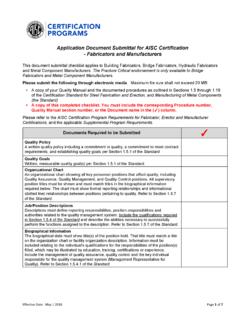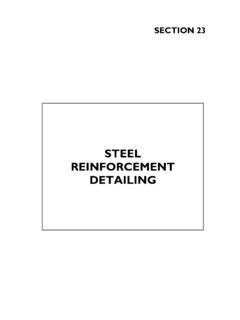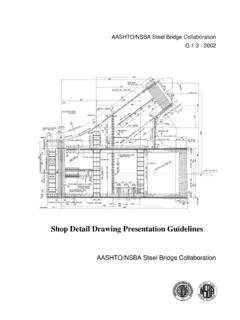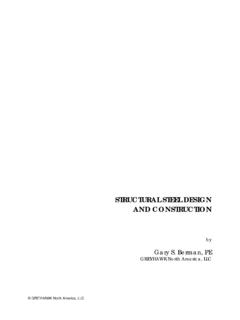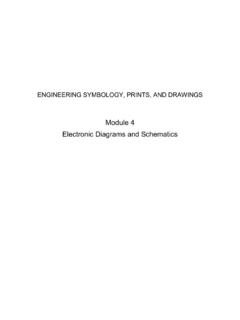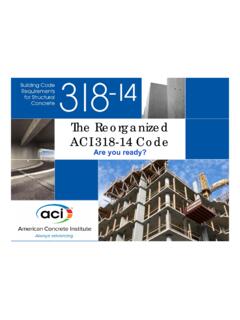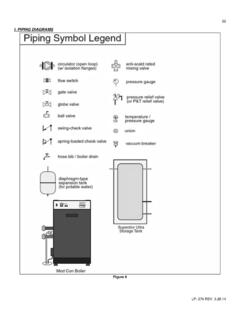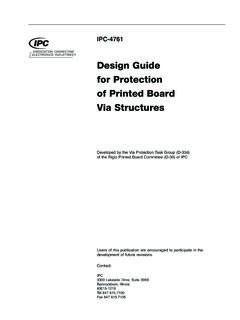Transcription of DETAILING STAIRS - AISC
1 Modern Steel Construction / October 1999 DETAILINGSTAIRS:Basic Principles & Common PracticesBy Andrew J. BellerbyThis article is designed to provide anintroduction to DETAILING STAIRS . Itexplains the basic principles and com-mon practices of DETAILING STAIRS , both byhand and with automated programs. Covered in this article are typicalstairs in American and Canadian indus-trial and commercial buildings, wheregrating and concrete-filled pans areused. This article does not cover orna-mental or circular :The tread is the piece of steelthat makes up the steps of the 1: StairTerminologyThe tread can be made from grating orfrom pans (both shown in Figure 1).Grating is typically used in industrialbuildings while pans are usually used incommercial structures. The grating typeof tread is plate, but the pan shape dipsdown so that the concrete can be pouredinto its base.
2 Sanitary-type pans, which are com-mon in hospitals, have an additional lipthat prevents dirt from falling into thecorner of the pan.(Pan and grating treads are shown inFigure 2.)Stringers:The stringers support theends of the treads. Stringers are oftenrectangular hollow sections, channels orplate. The top of the stringer is connect-ed either to a supporting beam or to adog leg (see Figure 3).The bottom of the stringer is connect-ed to a supporting beam, a dog leg, orthe ground. If attached to a supportingbeam, the stringer can be bolted orwelded. If attached to a dog leg, thestringer will be Beam:The supportingbeam supports the stringer or the dogleg (if it exists). Each stringer can beindependently supported. Alternately,both stringers can be supported withthe same supporting beam. The sup-porting beams are usually wide flangesections or legs:The location of the support-ing beams determines whether dog legsare actually needed(as shown in Figure4).
3 A dog leg is needed when a viableconnection cannot be made to the sup-porting beam directly from the dog leg can be the support for thelanding at the top of the stair, if pans:These are required atthe top and bottom of a pan stair. Onespecial pan closes the stair against theconcrete or platform, and the other pancloses off the top of the stair(see Figure5).Modern Steel Construction / October 1999 Figure 2: Grating andPan ThreadsFigure 3:TypicalStringer &Dog LegConnectionFigure 4:Determiningwhether a dog-legis requiredModern Steel Construction / October 1999 LOCATIONThe main parameters forlocating the STAIRS are: Rise and tread Nosing points and nosing line Stringer offset values Dog leg to nosing point height Safe rise and safe run Number of treadsAn explanation of these termsfollows:Rise and tread: Although theactual stair step is called thetread, there is also a measure-ment, as shown in Figure 1,which is termed the 'tread'.
4 Thisis the horizontal distancebetween two consecutive rise is the vertical distancebetween two consecutive line and nosingpoints: In order for the stair tobe set up properly, every cornerof every tread should passthrough a single line. That lineis called the nosing line, and thecorner points on the treadthrough which the line traversesare called the nosing offset value (top ofsteel of stringer to nosingline): As shown in Figure 6, thestringer offset is the perpendicu-lar distance between the top ofsteel of the stringer and the nos-ing line. The stringer offsetvalue is required for locating thestringer in leg to nosing pointheight: Where dog legs arerequired ( cases where thestringer can't directly make aviable connection to the support-ing beam), it is necessary tolocate the dog legs.
5 The top dogleg to nosing point height is thedistance from the top nosingpoint to the top of steel of the topdog leg. The bottom dog leg tonosing point height is the dis-tance from the bottom nosingpoint to the top of steel of thebottom dog 5: Specialpans at top andbottom of stairFigure 6: Stringeroffset ( toNosing Line)Safe rise and safe run: The fol-lowing general guidelines aretypically used for indoor STAIRS ininsuring that the stair is safe: 3/16maximum variation in riseor tread is allowable. 2 x rise + tread should bebetween 24 and 25 . Rise + tread should bebetween 17 and 171/2 . Angle of the stair should bebetween 20 and 50 : tread minimum and risemaximum, as well as otherimportant parameters are gov-erned by local or state of treads: The numberof treads is obtained by dividingthe total rise by the safe rise, oralternately by dividing the totalrun by the safe to stringer: A typicalgrating to stringer connection isshown in Figure 7.
6 The gratingmanufacturer specifies the loca-tion of the bolt to stringer: A typical panto stringer connection is shown inFigure connection typesinclude double angles with asquare rod bent around the panand welded to both the pan andthe to dog leg: A commonstringer to dog leg connection isshown in Figure is awelded connection with bothends to ground: A commonstringer to concrete floor connec-tion is shown in Figure Steel Construction / October 1999 Figure 7: Typicaltrtead to stringerconnectionsSketch 1: Stair nosing set-out pointsSketch 2: Stair layout withstringer connectionsSketch 3: Stair layoutwith detail dimensionsSketch 4: Stair layoutwith detail dimensionsHAND DETAILING OF STAIRSI nformation from the engi-neer: The detailer must firstreview the engineer's layoutdrawings to determine whetheror not all the required informa-tion is present (see "Informationwhich designers should provideto detailers").
7 If this informationis not present then the detailershould submit an RFI to of the nosing points:If the required information isavailable, then the supportingsteel can be drawn to scale usingconstruction lines, and the nos-ing lines can be drawn. SeeSketch the main members:Next, draw the main stringers,and if required, draw the doglegs onto the stair layout. SeeFigure 5 for the method of deter-mining whether dog legs arerequired. Once the main mem-bers are in position then thestringer connections are detailedboth to the concrete floor and / orto the supporting steel. SeeSketch the Pans or GratingTreads: Draw in the gratings orpans along the nosing line at thecalculated positions. If a panstair is being detailed, only thetop, bottom and one typicalintermediate pan are required todraw the nosing line.
8 See the Detail: Afterthe completion of the stair dia-gram the dimensions for fabrica-tion can be calculated and addedto the detail. The weights mustalso be calculated for the Bill ofMaterials to complete the stairdrawing. See Sketch entire process in 2-D,including drawing the connec-tions, can be completed in abouttwo to three Steel Construction / October 19993-D STAIRSB ecause fabrication and erec-tion of STAIRS is a 3-dimensionalproblem, using 3-dimensionalmodeling can be a very usefulmethod of DETAILING . In 3-D, thedetailer models a physical fullsize representation of the struc-ture, and the computer thenautomatically produces the fabri-cation drawings . The detailercan walk around the structureand view it from any perspective,and build any connection. Everyaspect of the structure is seen onthe screen in front of the detailerso potential problem areas canbe eliminated immediately.
9 Thegeneral layout for 3D STAIRS isshown in Sketch of producing stairsin 3-D: A stair will usually con-nect either to concrete or to asteel platform, so the detailermust tell the computer whichtype of platform to Steel Construction / October 1999 Sketch 5: General3D layoutThe detailer specifies whethera pan or a grating tread will beused, the number of risersrequired, the stringer sectionsize and the stringer offset (ordistance from top of steel ofstringer to the nosing line). Thetread vs. rise ratio and whetherthe stair is generally safe (seethe section on 'safe rise and saferun') are automatically a standard rise and treadare selected then the pan can bepicked from a database of exist-ing sections. If not, then the newpan section will be created auto-matically (an automatically mod-eled pan is shown in Figure 8).
10 The detailer can specify dimen-sions for the tread thickness andthe toe space but the tread andrise is automatically determined. From beginning to end, theentire stair, including modelingthe stair, producing the drawingand drawing the connections, canbe completed in less than 10 can be detailed manual-ly in 2D, or automatically in complex, manual draft-ing is very common and is widelyused. Automatic DETAILING ofstairs in 3D is becoming increas-ingly common because it is sim-ple and fast, helps the checker(because the stair can be visual-ized in 3-D), and ensures a goodfit and subsequent ease of which designersshould provide to detailers Number of treads and the rise(typically given as 16@61/2") Stringer size and type ofstringer ( channel, or tube) Supporting beam sizes andpositions Nosing points (if possible) Connection details (if possible)Andrew J.




